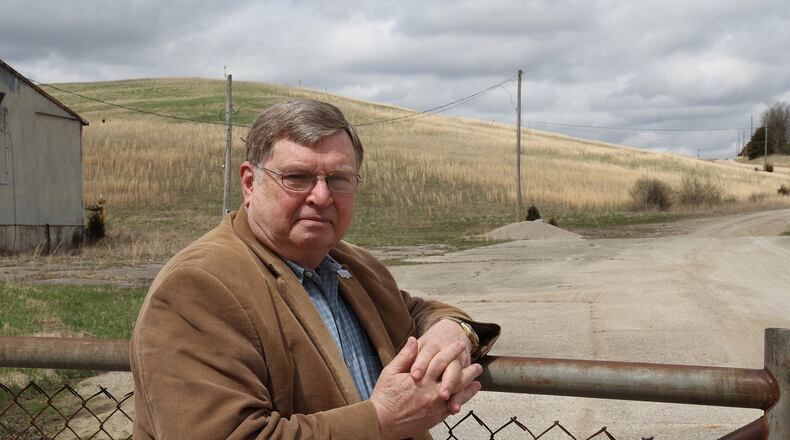Foley was not happy with the explanation he received.
“My feeling is that, over time, the TIF and CRA will bury Springfield Twp. and the Clark-Shawnee Schools,” Foley told the commission.
Clark-Shawnee Schools has challenged the plan they say will cost the district needed revenue while potentially adding more than 375 new students to their classrooms over a period of years as the development comes together. The district has filed a civil lawsuit claiming a recent Central CEDA Regional Planning Commission meeting on the topic violated Ohio’s open meetings laws.
Estrop responded strongly to Foley’s assertions, stating under the current proposed structure, Clark-Shawnee Local School District will receive an estimated $63 million in new tax revenue over a 30-year period.
“The original proposal would have generated $66 million for the Clark-Shawnee School District. That proposal was rejected by the school system,” he said.
He indicated a second proposal was offered by the developer, Borror Real Estate from Columbus, that would have amounted to an estimated $71 million dollars in tax revenue over the 30-year time frame. The Clark-Shawnee School District rejected that proposal too, he noted.
“They have settled for a proposal that generates $63 million, so according to my calculations, Clark-Shawnee School District left somewhere between $7 and $8 million on the table that was offered by the developers to that school system,” Estrop said. “They are not in any way being cheated out of tax dollars. They will gain substantially from this development.”
Clark-Shawnee Superintendent Brian Kuhn told the News-Sun on Wednesday afternoon they have no say or acceptance authority in the current $63 million proposal.
“Estrop failed to mention ... based off the developers own calculations, that the cost to educate the anticipated number of students out of just the single-family homes, not including the apartments and patio homes, over that same 30 years, would cost $71,640,000,” he said. “And this is based on the assumption that the cost to educate students doesn’t go up over those 30 years.”
Kuhn said that’s still a $5-6 million deficit from the first $66 million proposal and over a $700,000 to $800,000 deficit in the $71 million proposal.
“The cost to educate the children just from the owner-occupied homes exceeded the revenue among all three proposals over the same 30 years,” Kuhn said. “If the commissioners assume the anticipated revenue is accurate, then the estimated cost to educate kids also needs to be considered accurate. Even at the end of 30 years, projecting the $60+ million revenue amounts, that still is insufficient based on the developer’s own calculations.”
Estrop also offered statistics on enrollment in Clark-Shawnee Schools, reporting that in the past the district had more than 200 students enrolled through open enrollment from outside of the school district.
“That’s 200 seats that were taken by students from other school systems. I will give them credit, they have now reduced the number to 89 … who they are not required under state law to accept. Eighty-three students from Clark-Shawnee are now enrolled at Global Impact STEM Academy. So we have a total of about 170 student seats that are available for additional growth at Clark-Shawnee … This development will happen over time, and I don’t think there will be a glut of students, nor do I think the district is going to be in difficulty financially.”
Kuhn said the district does not have 170 open enrollment seats and called Estrop’s math faulty.
“We are filling the seats vacated by GISA students with open enrollments, so if we see an increase in resident enrollment, we continue to decrease open enrollment,” Kuhn said.
The district has 89 open enrollment seats, he said, and has 83 students attending GISA. If those 83 students were to return to Clark-Shawnee for any reason, they would have to displace the open enrolled student from their existing seats, Kuhn said.
Officials point to the valuation of the property improvements that will change with development of the 400-acre Melody Parks development, which will include single-family and multi-family residential options, retail and restaurant components.
The commission’s public hearing for the resolution approving the Melody Parks New Community Authority was a first reading and requires a second regular meeting before a vote is taken on passage, likely to take place at the Dec. 5 commission meeting.
Kuhn said he’d welcome the opportunity for commissioners to hold a work session before their next meeting where the developer walks through the projections upon which Estrop based his comments because Clark-Shawnee has not seen the projections of the current state of funding.
“We are requesting this work session because we were pleasantly surprised to hear of the city commission’s desire to collaborate,” per their comments in a Springfield News-Sun Nov. 19th article about CEDA,” he said.
After the meeting, Jeff Fontaine, president of the development company Borror, said the company still hopes to break ground before the end of 2023.
“We are anxious to start,” he said. “We have a lot of people ready and waiting to get this project underway.”


